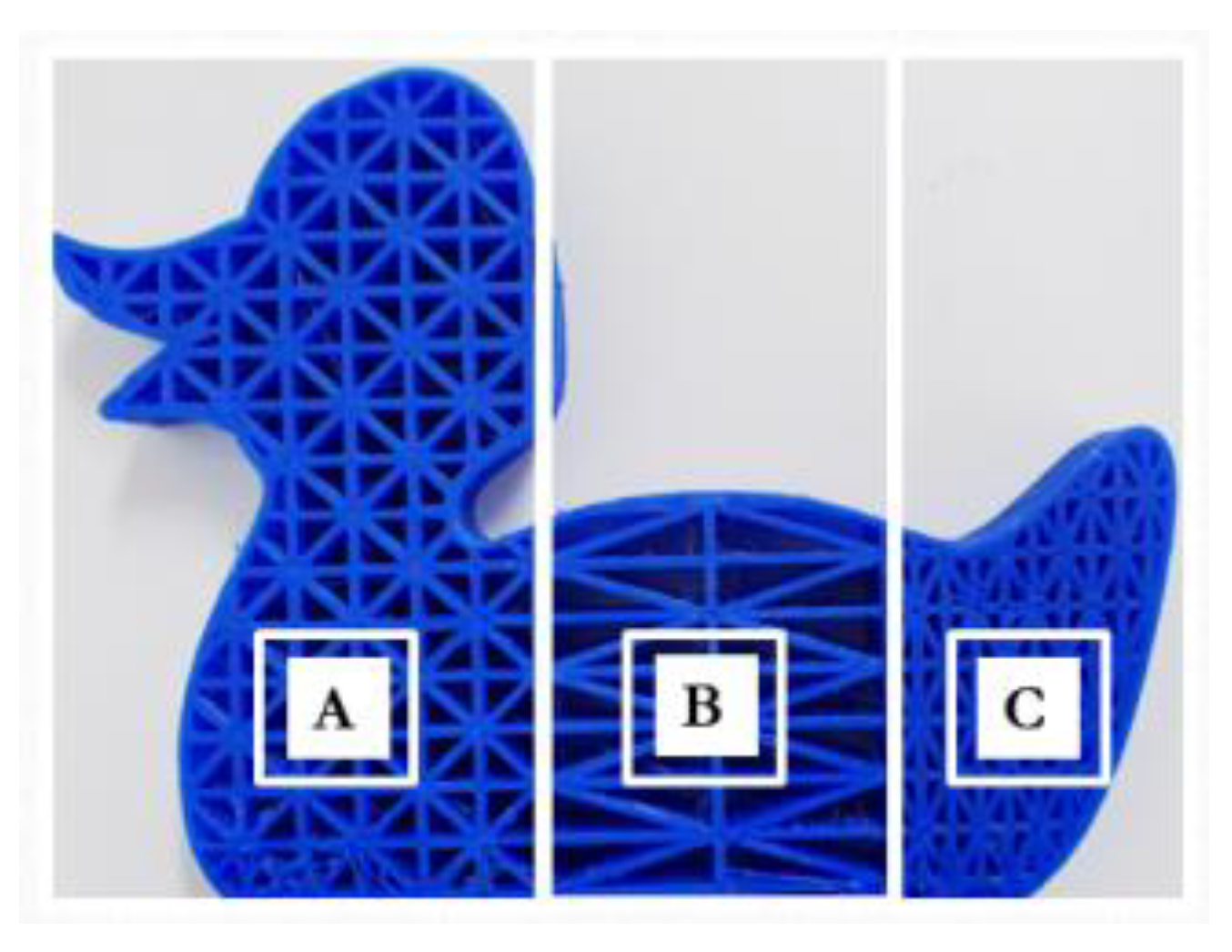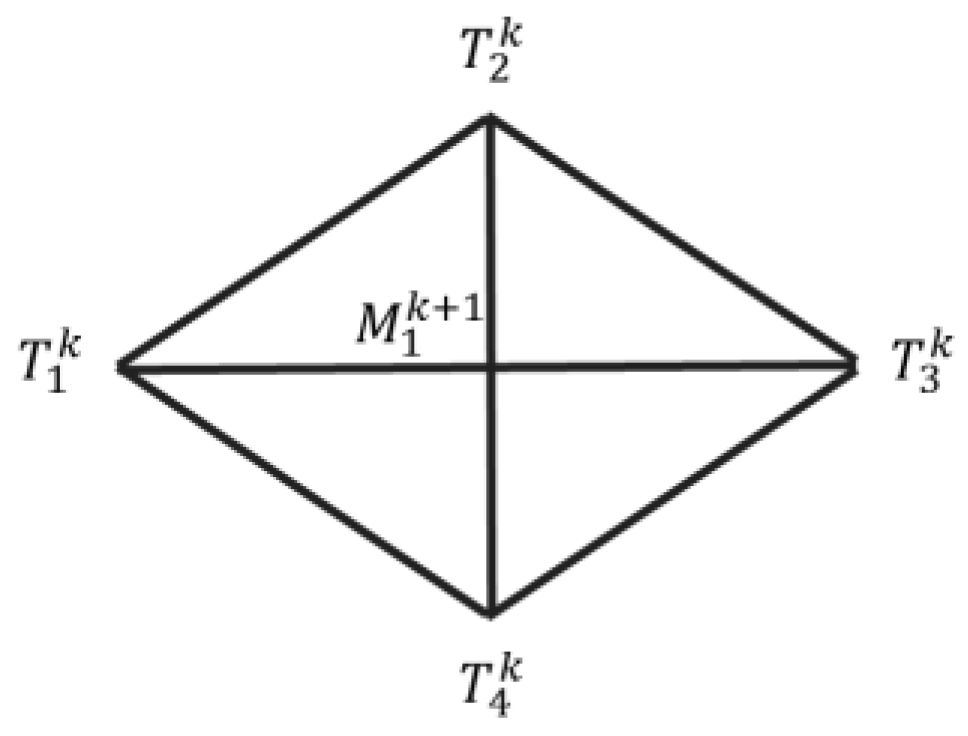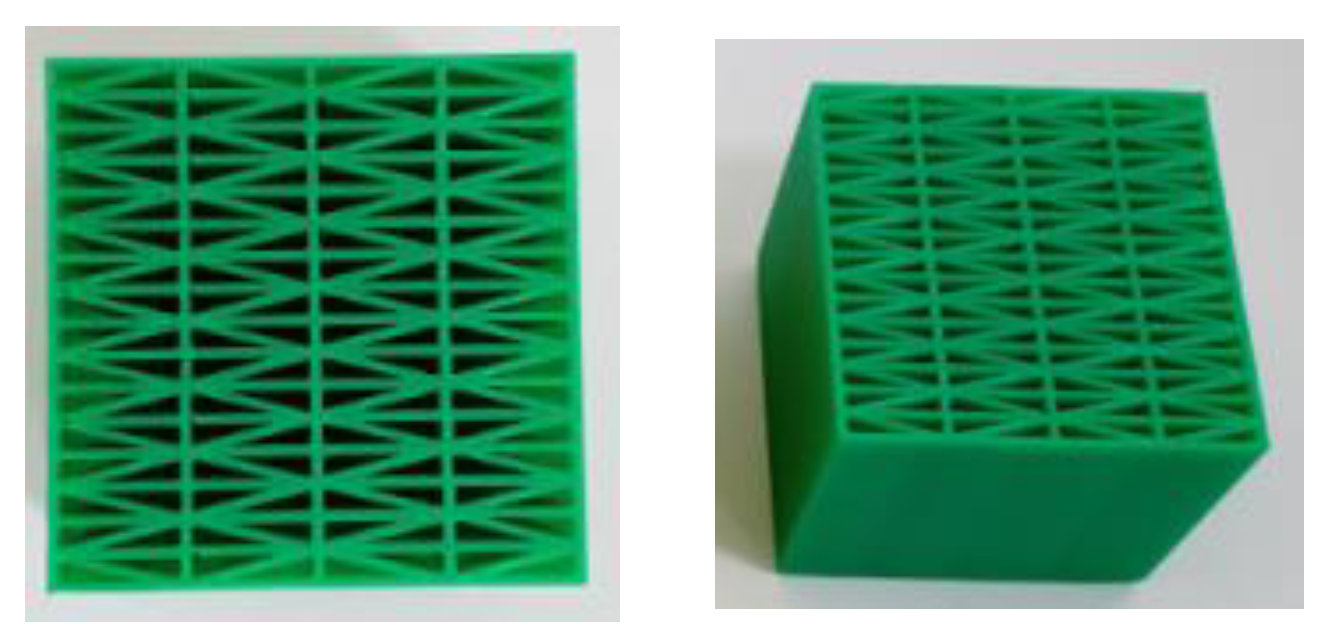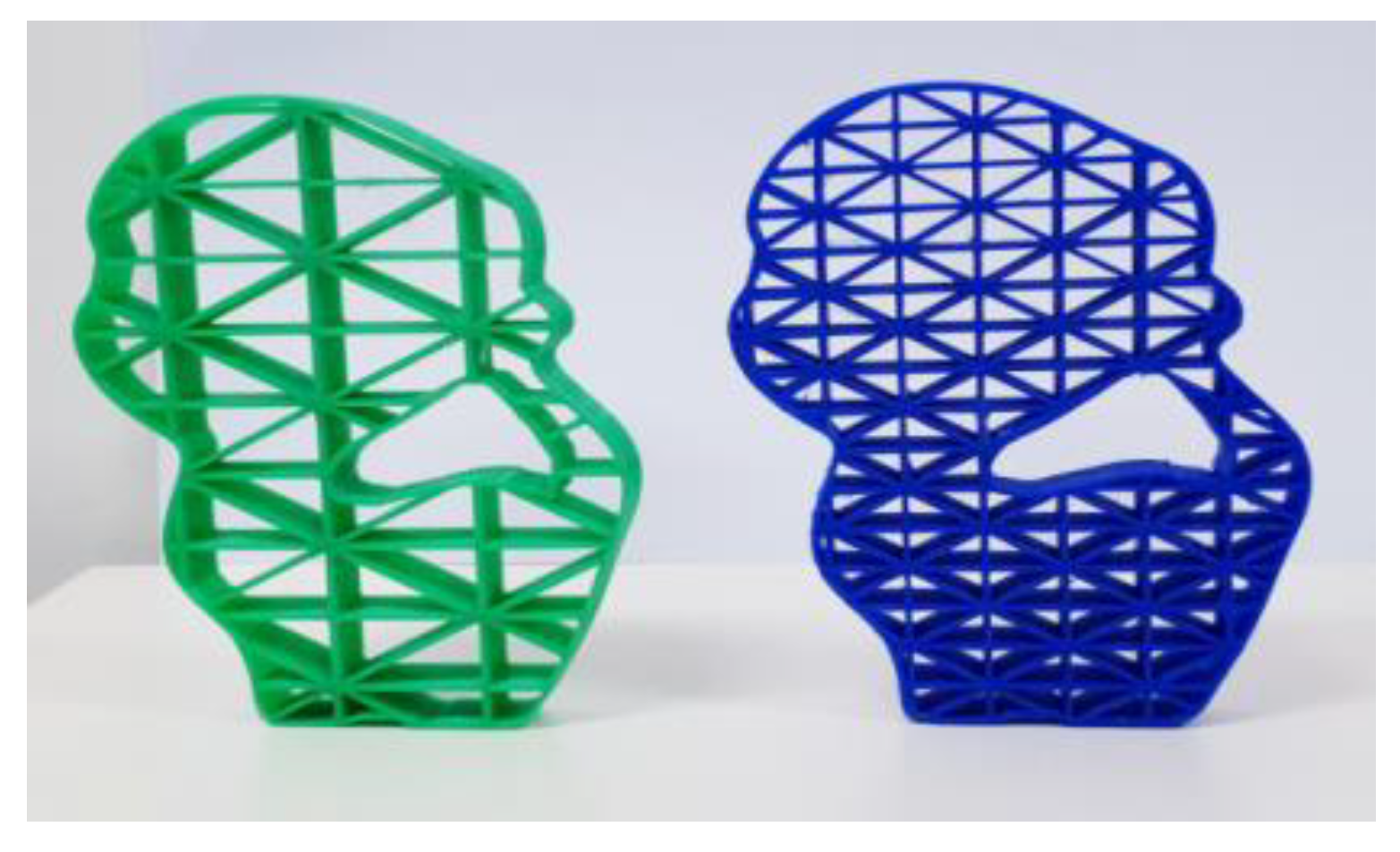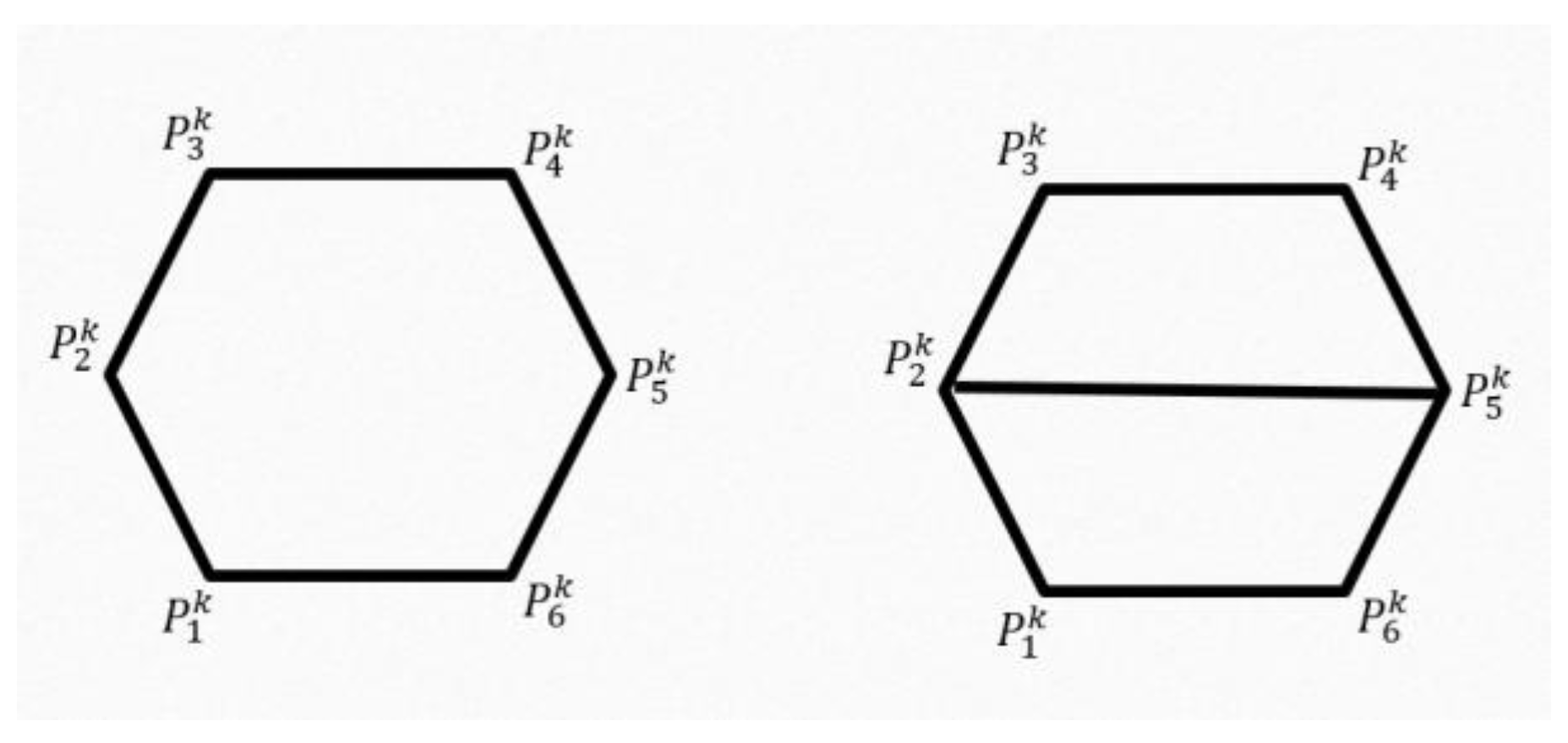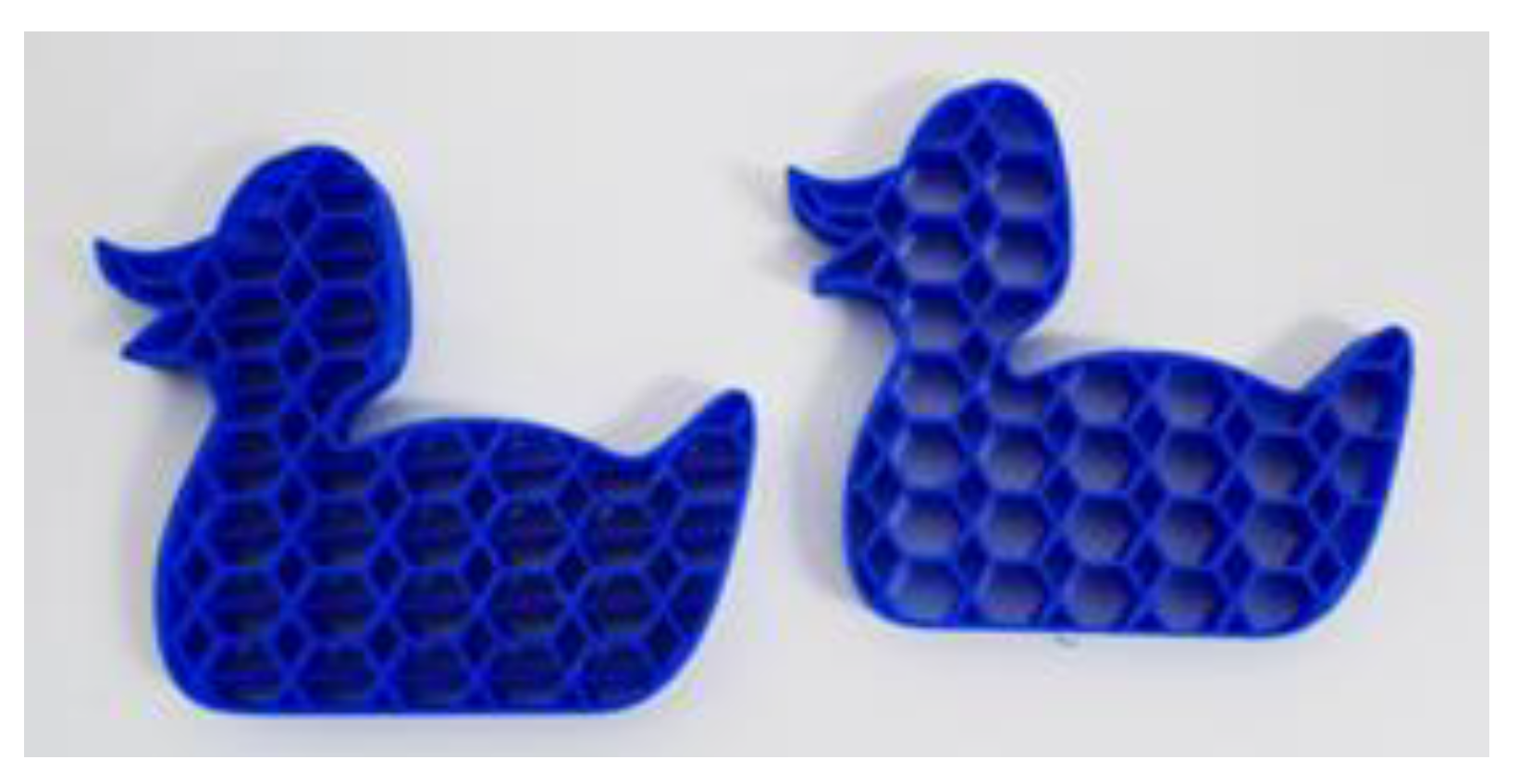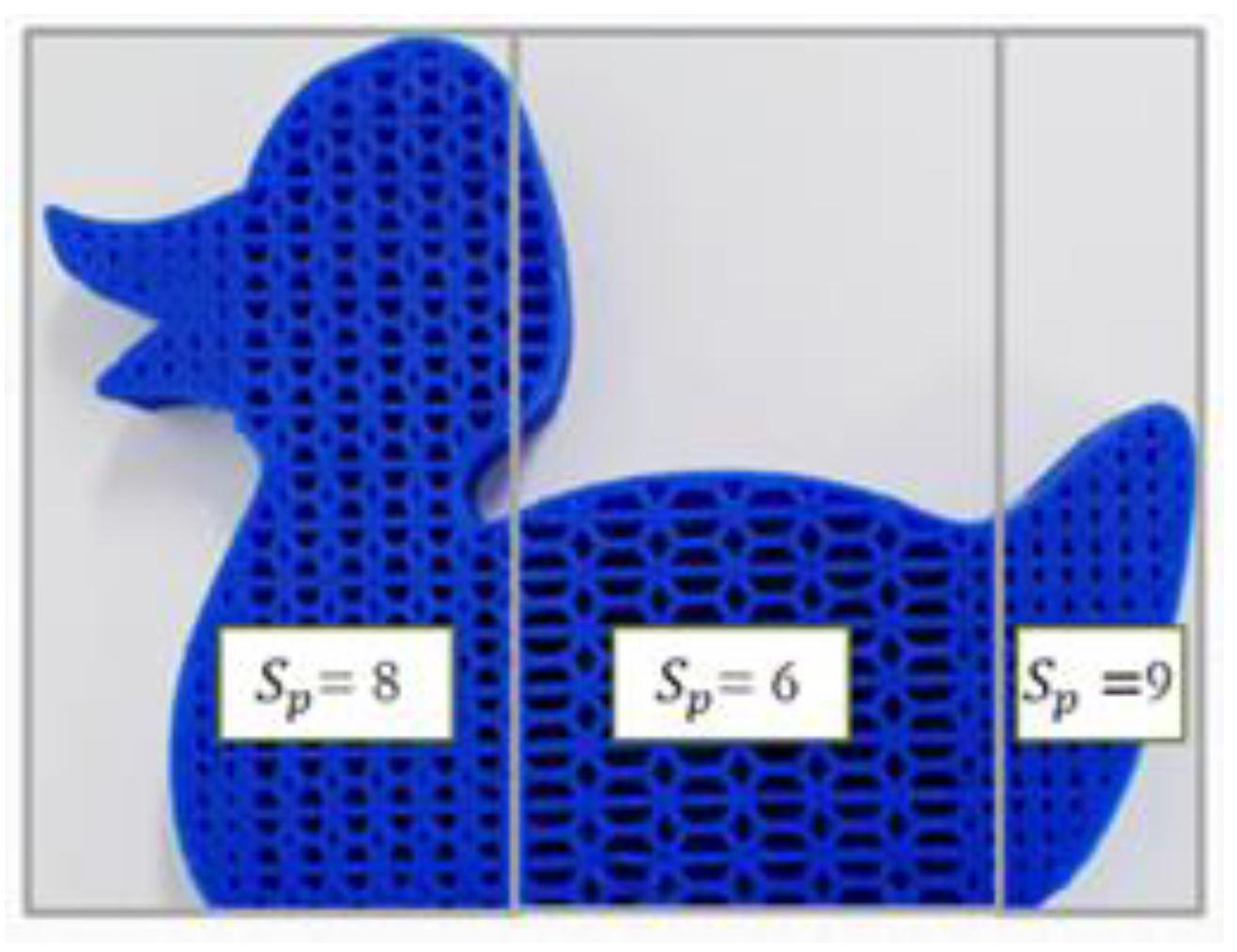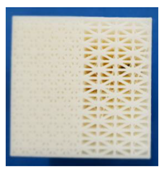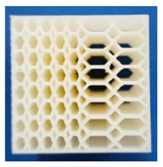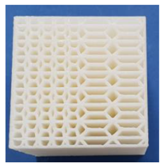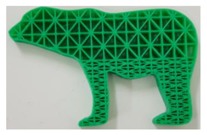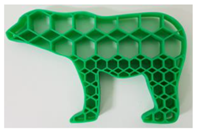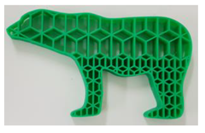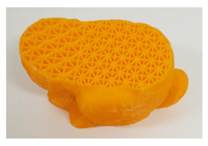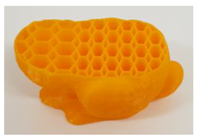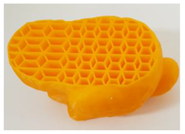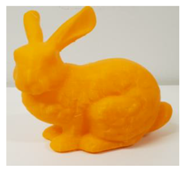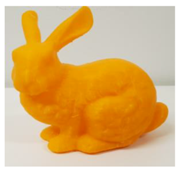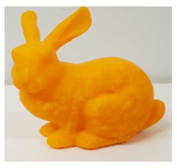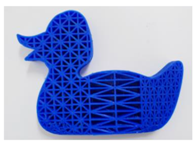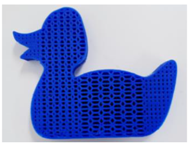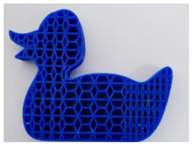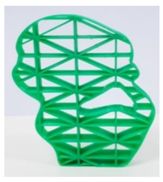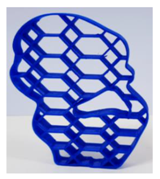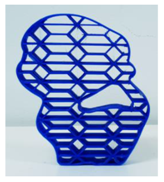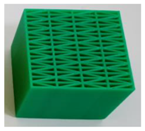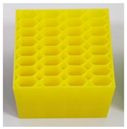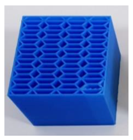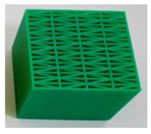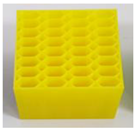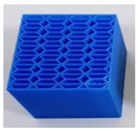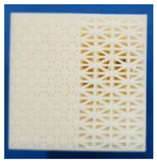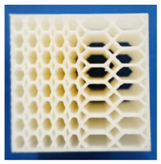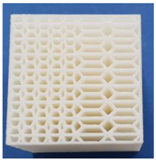1. Introduction
Recent additive manufacturing technology enables to fabricate objects with any geometrical complexity from scanned real objects or designed digital models. Additive manufacturing is widely integrated into different fields through various fabrication methods such as the fused deposition method (FDM) [
1] that prints objects by layers, stereolithography (SLA) [
2], and the selective laser sintering method (SLS) [
3] for manufacturers.
Modeling tools [
4,
5,
6] allow users to design objects with the desired shape and complexity. To improve the durability and mechanical properties of 3D fabrications, there is an efficient and practical approach that fills the interior of 3D fabrications with geometrical patterns using various slicing tools [
7,
8,
9].
In addition, numerous studies focus on the interiors of 3D fabrications to achieve specific functions in terms of the quality of printed objects. An alternative approach to interior structures is the topology optimization that deforms the original shape of the provided design. Commonly, topology optimization algorithms greatly improve the structural soundness of 3D fabrications, as well as minimize material consumption. However, they are not feasible for topology sensitive designs such as mechanical designs, where any geometric interference is not required, and most of the industrial samples demand high topological accuracy. In fact, mostly 3D fabrication techniques are used for creating 3D models with certain functions and purposes, where any geometry modifications do not occur. Moreover, most of the topology optimization methods are complicated, due to the complex and time-consuming pipelines.
Among the studies dedicated to infill patterns, the most related work is adaptive multilevel interior structures [
10]. Multilevel design is the best choice for the interior of 3D fabrications as it improves the physical properties of 3D objects and saves printing material.
The existing slicing tools control the pattern size with the volume percentage, but it is difficult to estimate the final pattern size by only setting the required volume percentage. Compared with slicing tools, the proposed method enables the user to specify the number of columns and rows of pattern elements with the specific scaling parameter that generates symmetrically positioned patterns for each subarea.
Therefore, our method makes users to create tailored 3D fabrications with certain qualities in an easy way. In fact, the adaptive multilevel design improves the physical properties of 3D fabrications and reduces material consumption better than uniformly structured patterns—however, it is feasible mostly for simple geometries. In addition, the computational cost is high, and its integration can be complicated for geometrically complex patterns. On the other hand, the proposed method is applicable to many different patterns with different geometrical complexities. In addition, it can be combined with different patterns and can be integrated into 2D and 3D models with ease. Our approach can also balance conflicting requirements such as strengthening and reducing material consumption of 3D fabrications. Moreover, with a scaling parameter, users can create lighter interiors for 3D fabrications by manipulating the sizes of elements according to the user desired requirements. In our method, we use border conditions to prevent overlapping problems for each created subarea of a selected object area. Furthermore, we provide detailed descriptions of the designed subdivision schemes for each presented pattern. We developed three different patterns for our comparison test and integrated a scaling parameter for each scheme to generate outputs. We also applied a scaling parameter for uniformly structured patterns to conduct a comparison test between uniformly structured patterns and multilevel patterns developed by our method.
The main contributions of our study are the followings:
We develop a multilevel design approach with a scaling parameter where users can provide the number of columns and rows of pattern elements to create 3D fabrications with tailored qualities.
We develop three patterns and provide the designed subdivision schemes.
We show the practical application of our method in 2D and 3D models.
We focus on saving printing materials by creating lightweight 3D fabrications.
The rest of the paper is organized as follows:
Section 2 includes related work where we review previous studies on the interior patterns of 3D fabrications and subdivision methods.
Section 3 describes the construction of our method.
Section 4 and
Section 5 describe the details of the subdivision schemes for the developed patterns.
Section 6 discusses the experiment results, and the conclusion is provided in
Section 7.
3. Multilevel Design Construction
This section describes the construction of our method. In our study, the base area of the bounding box of an input model is considered as a target area, and the midpoint algorithm is used for creating subareas.
In our approach, boundary conditions are provided for preventing overlapping problems between subareas. The number of subareas is determined by the required demands. For each subarea, different values of
are given, which create different-sized elements by forming a multilevel design of a single pattern. The element size depends on the values of
and subareas. To create elements with a smaller size, the value of
must be increased. The element size can be defined as follows:
where
is the number of steps, where pattern elements will be created;
=
is the subarea; and
is defined as
and
can be vary for
and
depending on requirements. It results in unequal numbers of rows and columns. In this study
determines
for columns which can be written in an extension form as
where
and
divides sides of
, with the Euclidean distance as follows:
where
.
In our method, we consider an additional option to iterate after providing
, if iterations are performed, the number of element columns will increase at each refinement level according to the following arithmetic sequence:
where level,
is the term position, and
is the difference.
In
Figure 1, the base area of the present model was partitioned into three subareas as A, B, and C. Each subarea was created with different values of
. The construction of our method is illustrated in
Figure 1.
For each subarea we specified border conditions and
values as follows:
where
,
,
are the subareas;
is the scaling parameter;
is the selected area.
A feasible value of
is defined depending on the specific requirements. For strengthening an object we use a high value of
that is applied to fragile regions of the object, while the remaining parts are subjected to a low value of
, resulting in a multilevel design. Our method performs for patterns with different geometries. In addition, we can combine with other structures, as shown in
Figure 2. All of our output interiors are generated by applying
without iterations.
4. Star Grid (SG) Pattern
A symmetric grid mesh
with a given value of
is used and
can be written as
with
is the set of vertices,
is the set of edges and
is the set of faces;
is consist from
set of points
. Any element of
can be written in an extension form as the linear combination of the control points
,
. According to the topological rules of the SG pattern, new
mesh is created; with newly generated faces
and a new set of vertices
among
; here
; generally, the entire process can be represented by the following formula:
where
is the subdivision;
is the topological rules;
is the geometric rules. Formula (4) represents the general case for
.
Topological and Geometrical subdivision rules: The topological rule for the scheme is described by the process that begins with the generation of new elements; precisely, for each element face
, there are newly created faces
with a new set of points
, and its centroid
that is defined as
where
among vertices
. The entire procedure of topological subdivision is illustrated in
Figure 3. Each element of SG pattern is symmetric as it can be seen from the picture.
for the presented equations of SG pattern, where
. Each element of the newly generated
is constructed according to the subdivision scheme expressed by the following subdivision matrix:
here
is the set of points;
is the subdivision matrix.
As described earlier, the construction of our method involves creating subareas from the selected area to generate multiple patterns. For each subarea, different values of
are applied depending on the specific application. The practical application of our method is illustrated in
Figure 4.
During pattern generation, vertices are inserted according to the topological and geometrical rules of the subdivision scheme. In the generated SG patterns with new vertices
and faces
, the edges
are increased during iterations. SG pattern elements are generated through the nested subdivision process that is expressed as follows:
Here, the coarsest level is
and denser levels are
. In fact,
can be a competitive option when it is necessary to strengthen 3D fabrications. The presented subdivision scheme is designed to produce SG patterns. Moreover, in the scheme
is used to control the size of elements. The size of the pattern elements affects factors such as material consumption, printing time, cost, and weight, in addition to the stress-sustainability of 3D fabrications. Furthermore, the element size depends on the value of
and if we iterate from the refinement level and applied area. In smaller areas, the sizes of elements will be smaller even with a high value of
. We obtained outputs with
for the SG patterns, as shown in
Figure 5.
6. Experimental Results
We compared our method with uniformly structured patterns for 3D fabrications. We printed 2D and 3D models and conducted a comparison experiment by measuring their weight; moreover, we evaluated the mechanical behavior of the 3D fabrications by testing them using an electromechanical testing machine Instron-5690 (Instron, USA) to determine the exact external force sustainability. Compression was performed at a speed of 10 mm/min. We tested out our method with 2D and 3D models from different object categories (geometrical figures and animals). All the models were fabricated through an FDM 3D printer MakerBot Replicator 2 (MakerBot, USA) with a size 285 × 153 × 155 mm; we used acrylonitrile butadiene styrene as the printing material. Our platform was developed using C++ language with Visual Studio 2015 and rendered with OpenGL API.
We tested our method on different models and compared it against the uniform structuring method for each presented pattern. We applied in both methods to evaluate the efficiency regarding cost-effectiveness and additionally external force sustainability.
6.1. Multilevel Design vs. Uniform Design
In this part, we describe the results of the comparison experiments conducted between multilevel designing and uniformly structured patterns. We printed objects with different values of the scaling parameter to show the efficiency of our approach. The first experiment was conducted to reveal the lightest interior structure. We measured the weights of each presented 3D fabrication and compared them; the results are presented in
Table 1.
According to the experimental results, the lightest structure among the multilevel design patterns is the hexagonal pattern. Moreover, it can be considered a cost-effective structure and requires less printing time compared to patterns with more edges such as SG and hexagonal trapezoidal patterns. In fact, patterns with complex geometries consume more printing material, but they are beneficial for strengthening purposes. With our proposed method, material consumption can be minimized for patterns with complex topologies. The next part of the experiment involved determining how
impacted the weights of 3D fabrications. By dividing the base area of models into several subareas, we applied the feasible value of
for each subarea depending on the application specifications. The models presented in
Table 2 were divided into three parts with different values of
, a high value of
was used only for the thinner parts of the models to strengthen and achieve a compromise between physical property requirements such as strengthening and creation of lightweight 3D fabrications. The differences are clearly observable between two duck models with hexagonal trapezoidal interiors; one of them weighs 33 g, and the other weighs 23 g. This experiment demonstrated that the weights of the 3D fabrications could be controlled by manipulating the scaling parameter. Through the weight measuring experiment, we observed how
impacted the physical properties of the 3D fabrications.
Additionally, we performed comparison tests between uniformly structured patterns to experimentally evaluate the effectiveness of our developed patterns in terms of saving material. For the experiment, we printed 3D fabrications with the same scaling parameters
for kittens and
for cubes that are shown in
Table 3. As expected, the lightest pattern was the hexagonal pattern, owing to its geometry, that aids in the efficient use of material.
6.2. Stress-Sustainability Comparison
As a supplementary part, there was done the second experiment that evaluates the stress-sustainability of the created patterns. We performed compression tests exceptionally for the cube models as the geometry of the models influences the compression test results.
Therefore, we selected cube models with the three patterns to determine the stress-sustainability for each pattern. As it can be noticed from
Table 4, we experimented with uniformly structured patterns and multilevel patterns to show the efficiency of our proposed method and the designed patterns. The compression test results showed that the SG pattern was the best structure for stress-sustainability rather than the hexagonal pattern and hexagonal trapezoid. Although hexagonal structures are known for their high strength and durability among natural structures, they have revealed less stress-sustainability compared with SG patterns. SG pattern has a stronger structure than other patterns that makes more stress-sustainable.
The experimental results showed that the patterns developed using our method effectively resist external forces; moreover, our approach proved to be cost-effective that creates lightweight 3D fabrications.
6.3. Strengthening Thin Parts
As a supplementary part of our study, we considered strengthening thin parts of objects as different engineering applications require improved strength of thin parts in samples or industrial models. In fact, thins parts of objects less stress-sustainable, therefore we determined the thin parts of models via visual observation and strengthened them by applying a feasible value of
, as shown in
Figure 9.
7. Conclusions
The main novelty of this study was to demonstrate the successful application of our method for creating a lightweight interior for 3D fabrications and strengthening inner parts of 3D fabrications. In this study, we introduced the pattern element scaling parameter
that impacts the physical properties of 3D fabrications, as well as their weight, material consumption, and printing time. By manipulating
, it is possible to control the physical properties of 3D fabrications, including weights. Our method can be considered a goal-oriented fabrication approach that can satisfy the desired application demands for 3D fabrications. The experimental test provides the evidential proof of the efficiency of our method, the results of which can be seen in
Table 1. Moreover, we include subdivision schemes for each proposed pattern. We have shown practical applications of our method in 2D and 3D models, for the conducted tests we experimented with different models. A key advantage of our method is the controllability of 3D fabrication properties by introducing the parameter
.
